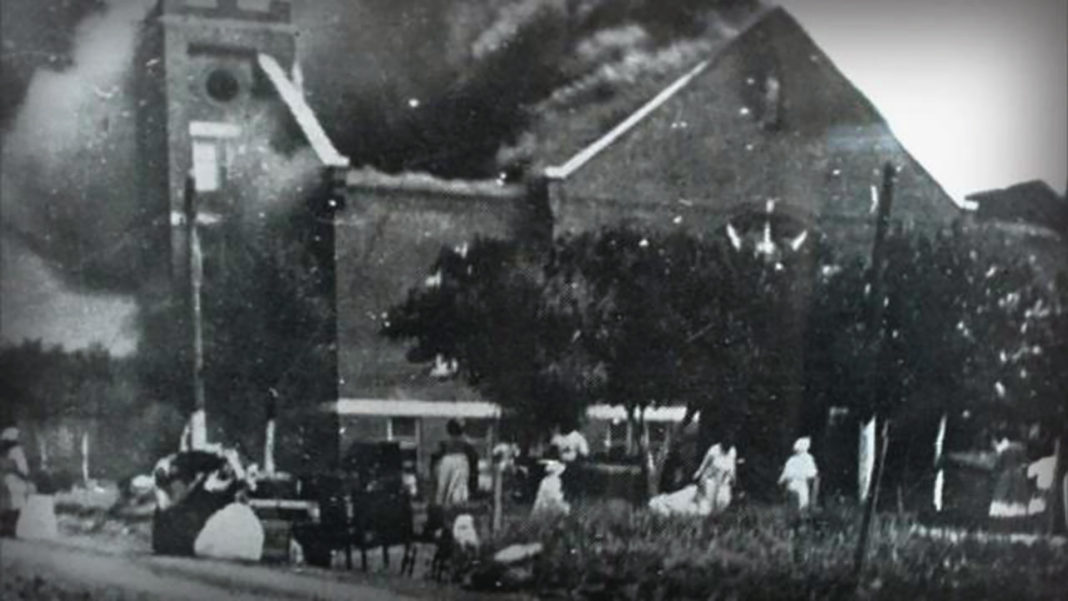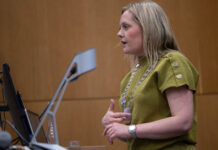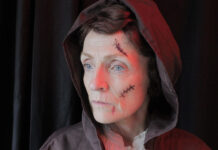African-Americans are outraged at US President Donald Trump’s decision to hold his first post-lockdown election rally this weekend in Tulsa, Oklahoma, where 99 years ago some 300 black people were murdered in the racially motivated Tulsa massacre.
“From my office window, I could see planes circling in mid-air. They grew in number and hummed, darted and dipped low. I could hear something like hail falling upon the top of my office building. Down East Archer, I saw the old Mid-Way hotel on fire, burning from its top, and then another and another and another building began to burn from the top.”
African-American lawyer B.C. Franklin’s eye-witness account of the 1921 Tulsa massacre gives a vivid and unflinching account of a day long-since ignored in US history, a day when black civilians were mowed down by machine-gun, and firebombs rained down from airplanes flying low overhead, a day when some 300 people were killed, and 10,000 were made homeless.
In 1921, the city of Tulsa, Oklahoma, had a population of approximately 72,000 people, perhaps 10,000 of them black. Racial tensions ran high in the city, with most black citizens segregated to Greenwood, an area of land once thought to be worthless, until an oil find there made many of its African-American and Native American residents rich. Greenwood’s thriving business district – sometimes referred to as Black Wall Street – was at the time the most prosperous black community in the United States, something which was deeply resented by its poor white neighbours. One contemporary estimate suggested that as many as 3,200 of Tulsa’s white residents were at the time members of the Ku Klux Klan.
On the morning of Tuesday, June 31, 1921 Buck Colbert Franklin (1879 – 1960) was a successful lawyer in his early forties, and his memoir, written ten years later, initially paints a picture of urban tranquillity.
“Sweet-throated birds warble their songs of joy in the tree-tops, fanned by the refreshing zephyr, and the dew sparkles upon the grass like countless little diamonds … An unbroken stream of pedestrians—male and female—passes down Greenwood Avenue. It is made up of laborers, some empty-handed and others with dinner pails, on their way to work. They hurry along as if they are late. A few of the more pretentious ones pass in their own cars, or in jitneys, or upon busses. Then comes a lull—a lull before the storm.”
The first sign of trouble came at 11.30am, with the first edition of the Tulsa Daily Tribune: “The newsies are hawking their wares, listen: ‘Tulsa Daily Tribune, Mister? Tribune, Mister? All about a Negro assaulting a white girl—read all about it—Tribune, Mister?’”
The day before, Dick Rowland, a black 19-year-old shoeshiner, had entered the elevator of the Drexler Building on South Main Street, heading for the top-floor restroom, which was restricted to black people. The elevator was operated by Sarah Page, a white 17-year-old girl. Something happened, and Rowland made physical contact with Page, and she screamed. Accounts vary, from his simply stumbling and catching her in his fall, to an attempted sexual assault. The 2001 final report of the Oklahoma Commission to Study the Tulsa Race Riot of 1921 noted speculation “that the pair might have been lovers – a dangerous and potentially deadly taboo, but not an impossibility.” Likely nobody will ever know, but whatever the truth, Rowland fled the scene and was arrested the following morning.
“To Lynch Negro Tonight”
The Tulsa Daily Tribune article B.C. Franklin mentions was headlined “Nab Negro for Attacking Girl In an Elevator”. Other witnesses reported an incendiary editorial entitled “To Lynch Negro Tonight”. No copies of the paper survive, and that page is mysteriously missing from the microfilm record.
Dick Rowland was imprisoned in a courthouse cell. By sunset, a lynch mob of several hundred white men gathered at the courthouse, demanding Rowland be turned over to them. Sheriff Willard McCullough and his men, though greatly outnumbered, stood their ground. Two hours later, a group of 50–60 armed African-American men arrived at the jail to support the sheriff and his deputies in defending Rowland from the mob. Ten witnesses would later swear to a grand jury that the black men were following the orders of Sheriff McCullough. McCullough publicly denied this. Confusion reigned. Shots were fired, and the black men were forced to retreat to Greenwood.
Law professor Alfred L. Brophy later argued that the police “made the riot worse” by deputising hundreds of white rioters. State legislator Don Ross, who later published the exposé “Profile of a Race Riot,” detailing Ku Klux Klan involvement, also found evidence of the mayor and the city commission plotting to “steal black land so that the ‘colored section’ could be pushed farther north”.
“When the eastern sky reddened, announcing the approach of day,” Buck Franklin wrote, “I was still standing (thinking) how different was the coming of this day from that of the day before.” As dawn broke on June 1, thousands of white rioters rampaged into Greenwood, looting and burning homes and businesses across 35 city blocks, and firefighters later testified that armed rioters had forced them back. Then, as the aircraft appeared overhead, Franklin witnessed the firebombing of Greenwood.
“Lurid flames roared and belched and licked their forked tongues in the air. Smoke ascended the sky in thick, black volumes and amid it all, the planes—now a dozen or more in number—still hummed and darted here and there with the agility of natural birds of the air.
“Then a filling station further down East Archer caught on fire from the top. I feared now an explosion and decided to try to move to safer quarters. I came out of my office, locked the door and descended to the foot of the steps. The side-walks were literally covered with burning turpentine balls. I knew all too well where they came from and I knew all too well why every burning building first caught from the top.
“‘Where, oh where is our splendid fire department with its half-dozen stations?’ I asked myself. ‘Is the city in conspiracy with the mob?’ As I stood there in contemplation of these and other gruesome facts, I saw two sights that will live in my memory to my dying days. One was a woman on the opposite side of the street. She was traveling south—hair disentangled and dishevelled—in the very path of whizzing bullets. She was calling wildly to a little tot that, a few moments before, had dashed in panic before her and turned off Greenwood on Archer at the corner. I hollered to her, ‘Turn back, woman, for God’s sake turn back. You will be mown down.’ Never turning her head, she answered, as she hurried on, ‘I must follow my child.’
“And so she did follow her child and not a bullet touched her although they literally rained down the street. This brave self-denying mother lives today here in Tulsa and with her that tot—now a splendid young lady—whom she risked her life to save.
“The other sight was occasioned by the Piro building catching on fire from the top. (This was a frame building then.) The fire dislodged those in the building—a woman, two children and three men. They emerged in wild confusion and came on in my direction. The little children—they were both girls—outran the others and passed the place where I was standing with the speed of the wind. The woman ran across the street and into the foot of the steps of my office building—right where I was standing—and fell upon her knees and commenced to pray, totally oblivious of my presence. I don’t think she ever saw me. And such a prayer—she asked God to save her and her children from whom she had just been separated. This prayer was uttered over and over. I am unable to say whether that prayer was answered or not. I have lived in Tulsa continuously ever since that memorable morning, but I have never seen that woman since. I know I would know her if I were to meet her, even today.
“The three men—one of whom lugged a heavy trunk on his shoulder—were all killed as they were crossing the street—killed before my very eyes. The man who carried the trunk was very old. Likely, he had in that trunk many things of great value (Negroes in Tulsa then were, as a rule, very wealthy) and thought as much of the contents thereof as he did of his own life. When the old man was hit—no doubt by a dozen bullets—he dropped his burden and shrieked and fell sprawling upon the hard-paved street. Blood gushed from every wound and ran down the street. I turned my head from the scene.”
A later Red Cross estimate suggested some 1,256 houses were burned; 215 more were looted but not torched. Two newspapers, a school, a library, a hospital, churches, hotels, stores and many other black-owned businesses were destroyed or damaged by fire. By the time the National Guard arrived and declared martial law shortly before noon, the riot had effectively ended. Although guardsmen helped put out fires, they also imprisoned many black Tulsans, and by June 2 some 6,000 people were under armed guard at the local fairgrounds.
In the end, 10,000 black people were left homeless, and the modern equivalent of $32.5 million worth of black homes and businesses were destroyed.
Buck Franklin and his family survived the riot. In the wake of the massacre, the Tulsa City Council passed an ordinance that prevented the black people of Tulsa from rebuilding their community. The city planned instead to rezone Greenwood from a residential to a commercial district. Franklin sued the city of Tulsa before the Oklahoma Supreme Court, and won. Black Tulsa residents began the slow, painful reconstruction of their community.
In the hours after the Tulsa massacre, Dick Rowland was released from custody, all charges dropped. He left town and reportedly never returned.
The Tulsa massacre has been long overlooked in US history, with many people only learning of it from Damon Lindelof’s faithful recreation of the atrocity in last year’s superb television “remix” of Alan Moore and Dave Gibbons’ DC Comics series “Watchmen”. From the immediate aftermath of the atrocity, America – white America, anyway – did everything it could to forget the Tulsa massacre.
To this day, we do not know for certain how many people died. The original estimates were of 36 dead. The 2001 state commission gave overall estimates from 75–100 to 150–300 dead. Nor do we know where most of the bodies are buried. A nurse told the Tulsa Historical Society in 1999 of an elderly white man’s deathbed confession “that he had killed many blacks during the riot and buried them near the railroad tracks – and would do it again if he had to.”
In 2018, Tulsa’s Republican mayor, G.T. Bynum, reopened an investigation into the sites of mass graves, searching two cemeteries and a former dump identified by witness accounts as possible grave sites. The investigation is ongoing.
B.C. Franklin’s testimony was only unearthed in 2015, and was donated to the Smithsonian’s National Museum of African-American History and Culture. It is beautifully written, but it reads like a horror story, going from the everyday to the apocalyptic in a narrative which instils dread in its reader. His account of meeting his friend John Ross, a young World War I veteran who took up arms to defend his fellow African-Americans, is particularly affecting. Franklin’s ten-page memoir is widely available online and deserves to be read in full.
Trump’s white supremacist welcome home party
Donald Trump’s choice of Tulsa for his first post-lockdown rally has been met with anger from the African-American community, with Senator Kamala Harris, strongly tipped to be Joe Biden’s vice-presidential candidate, tweeting: “This isn’t just a wink to white supremacists – he’s throwing them a welcome home party.”
While some might find it tempting to claim the venue was an unfortunate coincidence, it’s worth noting that Trump initially intended to have his Tulsa rally on Friday June 19, a hugely significant date in Black America. Juneteenth is celebrated as marking the end of slavery. Trump backed down last weekend, claiming “Many of my African American friends and supporters have reached out to suggest that we consider changing the date out of respect for this holiday … I have therefore decided to move our rally to Saturday, June 20th, in order to honor their requests.”
It seems unlikely that a man so proudly ignorant of history – especially African-American history – would have come up with so calculated an insult on his own, and some have speculated that this stunt bears all the fingerprints of Trump’s far-right advisor Stephen Miller. Either way, this is a very deliberate nod to Trump’s base, and appears designed to enflame racial tensions further.
At a time when George Floyd died begging for his last breath, sparking Black Lives Matter demonstrations across the globe, it remains to be seen whether a president who has nakedly courted racists and white supremacists will acknowledge that he is speaking at the site of one of the worst racist atrocities in US history.
Without wishing to appear disrespectful to George Floyd’s memory, even as Trump – a man who built his political career on racist dog whistling from the Central Park Five to the “Birther” movement – describes chokeholds as “so innocent and so perfect”, I wouldn’t hold my breath.








